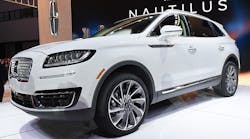How many SUVs is too many? It’s not a question that automotive product planners seem to be asking themselves, judging from the shiny sheet metal under the spotlights of this week’s Los Angeles Auto Show.
Fifteen football fields are filled with crossovers from Nissan Motor Co. and Hyundai Motor Co., and beefier sport utility vehicles built by BMW AG and Toyota Motor Corp. By 2020, more than 150 such models will be selling in U.S. showrooms, 50% more than at the beginning of this decade, according to researcher LMC Automotive.
The L.A. show floor encapsulates the gold rush going on in the American auto market to fill every nook of each crossover category. While total industry sales are slipping — a trend analysts expect to have continued this month — manufacturers have found respite in SUVs of all shapes, sizes and price segments that keep drawing more demand.
“We continue to see customers moving from sedans into SUVs, and it goes on and on and on,” Jose Munoz, the chairman of Nissan North America, said in an interview. “The rate of growth is going to come down, but there’s still going to be growth.”
U.S. sales of cars and light trucks probably ran at a seasonally-adjusted annualized rate of about 17.3 million units in November, according to the average analyst estimate in a Bloomberg News survey. That would be slower than the 17.7 million pace seen a year earlier, according to researcher Autodata Corp.
Nissan and Honda Motor Co. are expected to post the biggest gains among major automakers, while combined sales for Hyundai and its affiliate Kia Motors Corp. are likely to decline the most.
The new Kicks crossover that Nissan debuted in Los Angeles will battle with smaller models like the Hyundai Kona, one of eight new or redesigned SUVs the struggling South Korean automaker is bringing to the U.S. by 2020.
Hyundai is at risk of falling behind Subaru Corp. in total U.S. sales largely because of the relative strength of the Japanese brand’s crossovers. Subaru will bolster its lineup in 2018 with its first three-row model in four years, called the Ascent.
In the luxury market, Toyota’s Lexus unveiled a newly available three-row version of the RX and two-row variant of the larger LX. Ford Motor Co. took the wraps off its redesigned top-selling Lincoln, which scraps the MKX moniker for a new name: Nautilus. Nissan revealed two Infiniti big rigs, the QX50 and QX80. And BMW showed off the X7 Concept, previewing its most spacious kidney-grilled model beginning production next year.
“I guess you can argue the market is saturated,” Jeff Bracken, Lexus’s group vice president and general manager for the U.S., said in an interview.
Automakers are responding to a profound pivot in consumer demand away from passenger cars. Convertibles, coupes and sedans made up the majority of sales as recently as 2012. They’ve accounted for only a little more than a third of industrywide deliveries this year. Nissan forecasts that light trucks, which include SUVs, will be 70% of the market by 2022, Munoz said.
“The concern with this shift is for an industry prone to cycles, the growth in supply of crossovers may soon overtake demand,” said Jonathan Smoke, chief economist for Cox Automotive, which owns car-shopping websites including Kelley Blue Book and the vehicle auctioneer Manheim.
Incentives on crossovers already exceed those of cars, which is helping keep the sales momentum going, Smoke said. Next year, Cox estimates that light truck deliveries may increase about 2% while cars drop 11%.
Hefty discounts have made the small SUV segment as competitive as the cutthroat car business, Joe Hinrichs, Ford’s president of global operations, said earlier this month.
“We’ve seen competition heat up in that segment and I expect it to continue,” Hinrichs told analysts and investors at a Goldman Sachs conference in Boston. “It has felt some of those pricing pressures that the car business has felt.”
By Jamie Butters, with assistance from Keith Naughton and John Lippert



